Key Specs
Since many of our users are going to want to run different OSes on this, we wanted to give some of the key hardware specs. There is a lot on these machines that are customizable, but this at least gives you some sense of what hardware is available. If you want to know if your hardware is compatible with your OS, this list should help do that tie-out.
CPU Support
Here are the officially supported CPUs for the unit:
| Processor | Cores / Threads | Frequency Base/Max | Cache | Memory Support (Up to) | Integrated Graphics |
| Core i3-8145U | 2 / 4 | 2.1 / 3.9GHz | 4MB | DDR4-2400 | UHD 620 |
| Core i5-8265U | 4 / 8 | 1.6 / 3.9GHz | 6MB | DDR4-2400 | UHD 620 |
| Core i5-8365U | 4 / 8 | 1.6 / 4.1GHz | 6MB | DDR4-2400 | UHD 620 |
| Core i7-8665U | 4 / 8 | 1.9 / 4.8GHz | 8MB | DDR4-2400 | UHD 620 |
RAM Support
- 8GB or 16GB soldered. Non-upgradeable
Storage Support
- 1x M.2 PCIe Gen3 x4 for NVMe SSD slot
- 1x M.2 SATA/ PCIe Gen3 x2 SSD slot
Networking (Wired)
- Intel i219-LM
WiFi Support (Optional)
- Intel Wireless-AC 9560 (dual band), Wi-Fi + Bluetooth 5.0 combo adapter, 2×2
- Intel Wireless-AC 9462 (dual band), Wi-Fi + Bluetooth 5.0 combo adapter, 1×1
- Realtek RTL8822CE (dual band), Wi-Fi + Bluetooth 5.0 combo adapter, 2×2
- Realtek RTL8822CE (dual band), Wi-Fi + Bluetooth 5.0 combo adapter, 1×1
USB Ports
- 3x USB 3.1 Gen2 Front (2x Type-A, 1x Type-C)
- 3x USB 3.1 Gen2 Front (2x Type-A, 1x Type-C) Type-C is DisplayPort capable
OSes From Factory
- Windows 10 Home (64-bit)
- Windows 10 Pro (64-bit)
The OS section can be a big deal. Sometimes the units are advertised as supporting Windows 10, but one gets a Windows 10 Home license. If you want to, or may want to, run Windows 10 Pro, knowing exactly which OS is on the device is ultra important. Having Ubuntu Linux installed from the factory is nice since we know many of our readers will use these with Linux. We also had our system running Proxmox VE as a Linux virtualization node but that is not an officially supported OS. One also usually needs to make BIOS tweaks in order to run Linux on Lenovo machines since they are optimized for Windows.
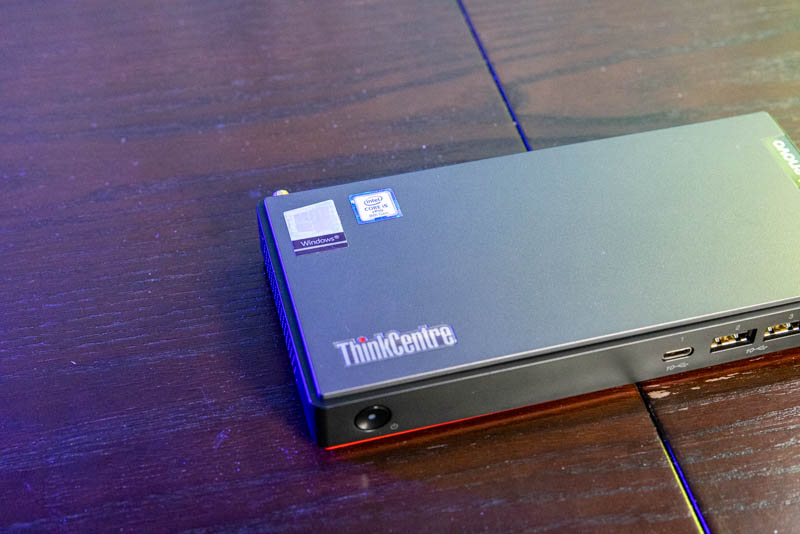
Note: These systems sometimes change specs mid-generation. If you find another spec sheet with items you think we should add, please let us know in the comments.
Next, we are going to look at the performance and power consumption before getting to our final words.
Lenovo ThinkCentre M75q-1 Tiny Performance and Power Consumption
Instead of going through the entire Linux-Bench test suite, we are going to show a few performance and power numbers here to give a general sense of performance. We actually planned to do storage testing, but then we realized that there was a huge variability in terms of what drives could be found in machines.
Python Linux 4.4.2 Kernel Compile Benchmark
This is one of the most requested benchmarks for STH over the past few years. The task was simple, we have a standard configuration file, the Linux 4.4.2 kernel from kernel.org, and make the standard auto-generated configuration utilizing every thread in the system. We are expressing results in terms of compiles per hour to make the results easier to read:
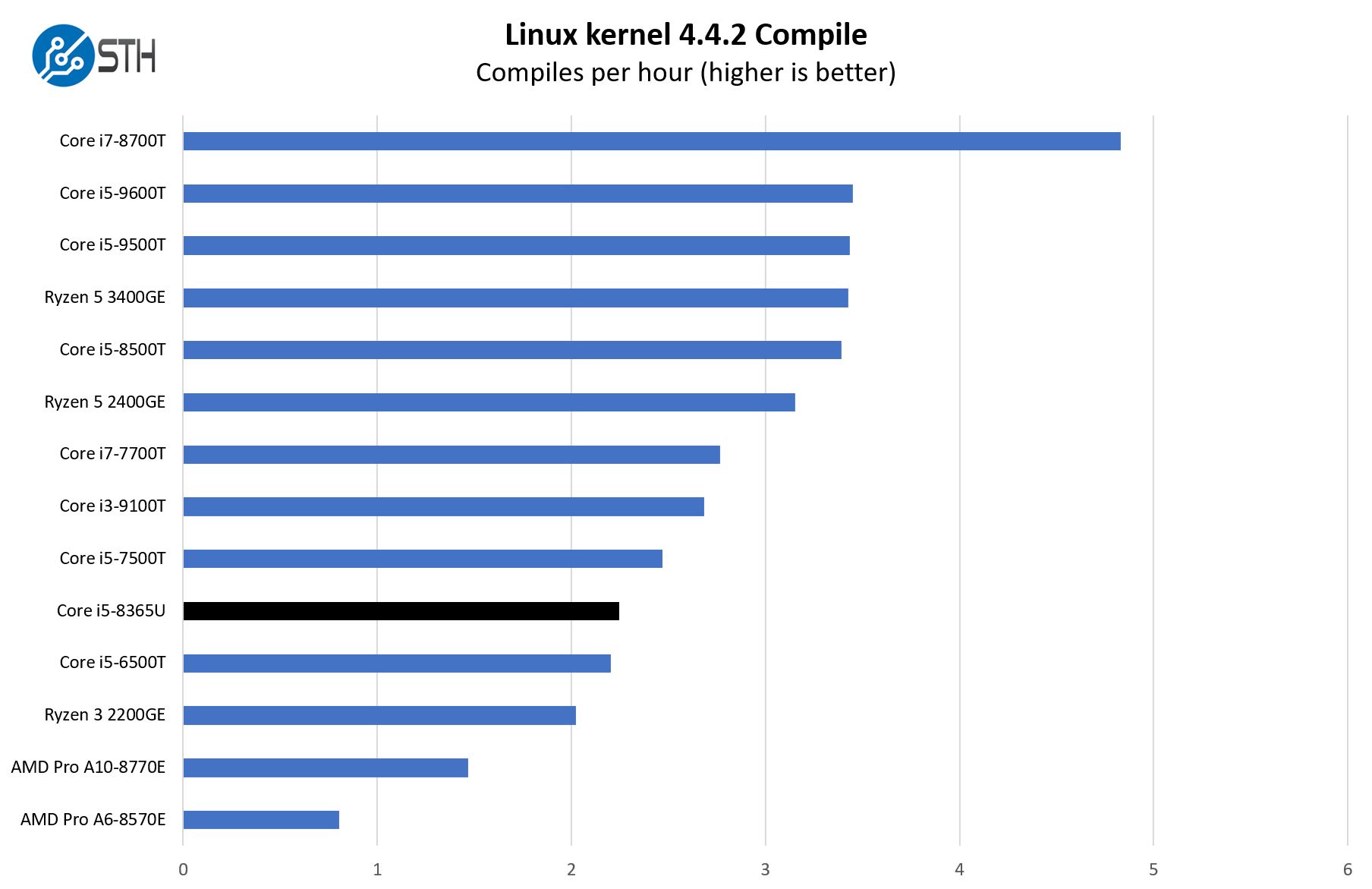
The performance of this solution is below a one-generation newer low-end Core i3-9100T part. It is also a bit lower than 4C/8T AMD Zen/Zen+ 35W solutions. That is not great.
7-zip Compression Performance
7-zip is a widely used compression/ decompression program that works cross-platform. We started using the program during our early days with Windows testing. It is now part of Linux-Bench.
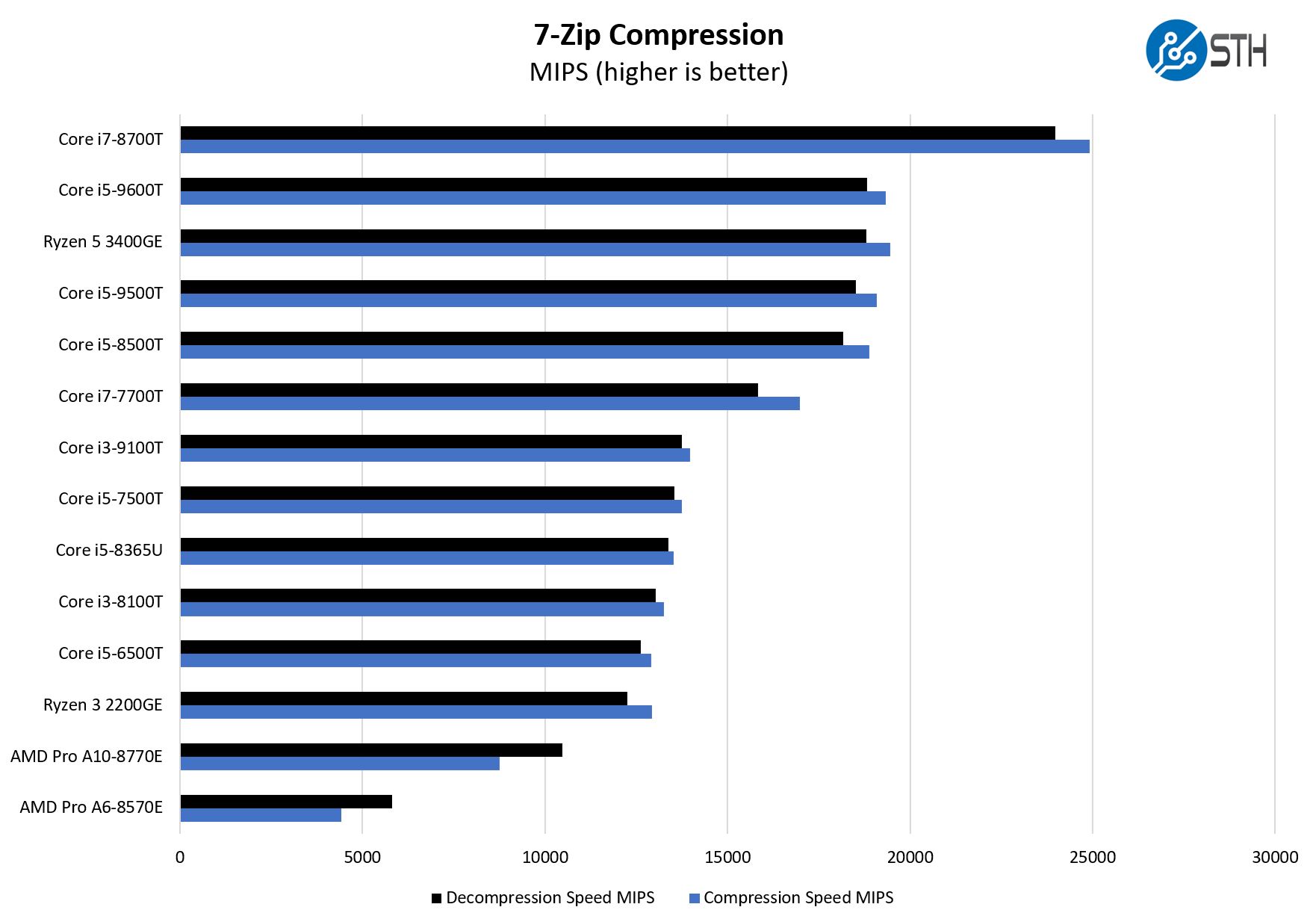
We also wanted to note that the Core i5-8500T is plentiful in 1L systems at a lower cost. We have not added the newer performance figures to this chart, but the new 10th Gen Intel and AMD Ryzen 4000GE units can get higher clock speeds, newer microarchitecture, and twice the core/ thread counts.
OpenSSL Performance
OpenSSL is widely used to secure communications between servers. This is an important protocol in many server stacks. We first look at our sign tests:
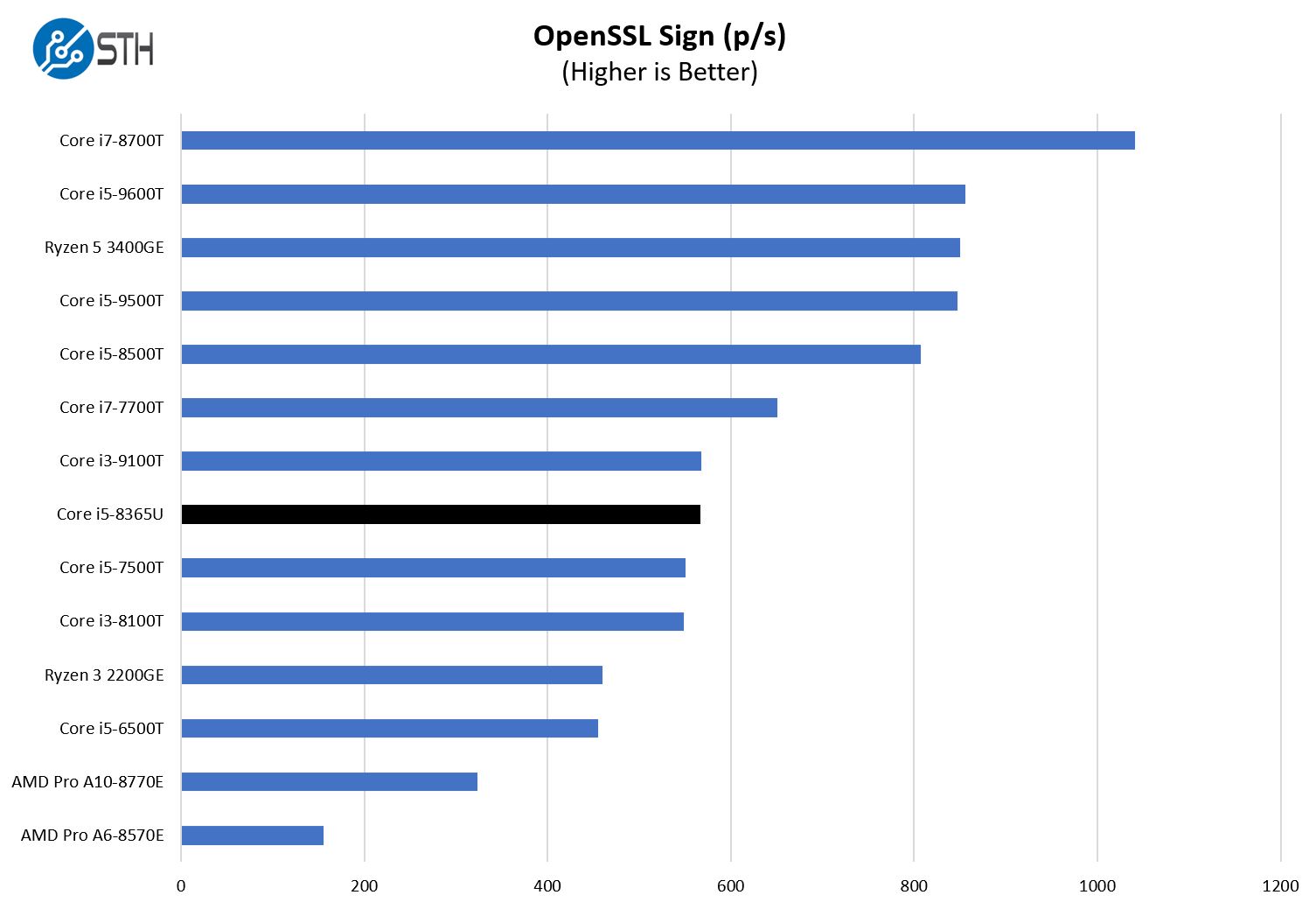
Here are the verify results:
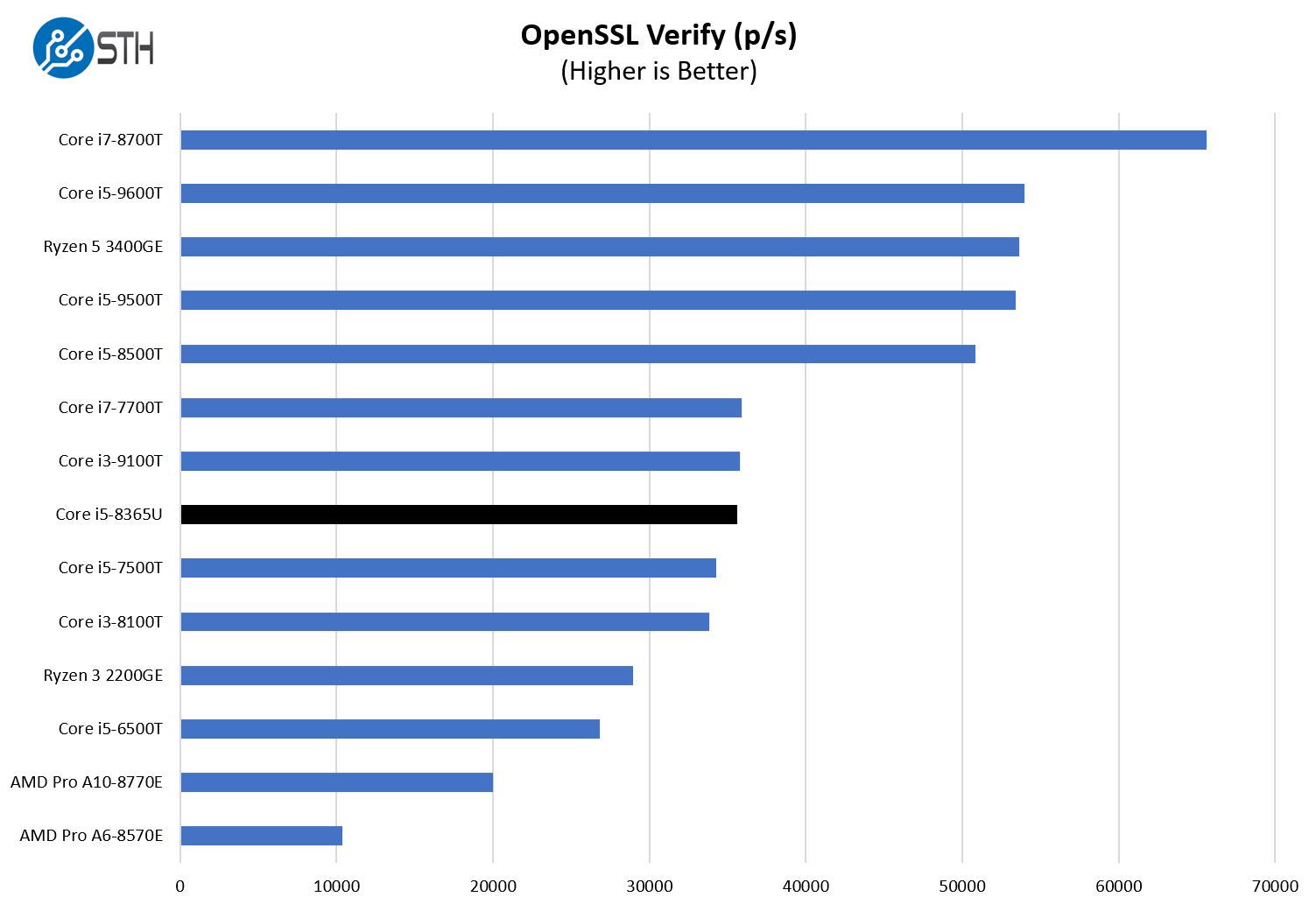
Something that we are not showing here is heat soak. When the Core i5-8500T 1L systems run for a longer period of time at higher loads, the performance we have seen maintain much better. On the Nano platforms, we can get good performance for short periods of time, but under full load and heat soak, we get lower clock speeds which hurt performance to where the Core i5-8500T can offer twice the performance of one of these nodes.
Next, we are going to take a look at power consumption before getting to our key lessons learned and final words.




When reviewing a small-form-factor system that is throttling due to inadequate cooling, it would be nice to include a stress test that directly measured FLOPs, clock speed and temperature over time, for example, while running something like high-performance Linpack. Any similar cooling-system stress test wound be welcome.
It’s Wonderful!
I would like to mount the TinyMiniMicro onto camera tripods, analytical/optical benches (lab), to being part of a package attached to physically larger projects e.g. in the observatory, riding the telescope, to having hardwire ether and more compartmentalized for secure lab/facility, performing dedicated function sets e.g. LabVIEW. I also like the USB 3.1 Gen2 port with the less diminutive A like style connector, rather than being limited to a manufacturer selfish and current trend (creates hardware personality matching issues), less robust/inclusive USB 3.1 C.
I’m really puzzled by the design process that would produce something like this.
For laptops you can understand(if not always agree with) thermal compromises because every gram is a gram that the customer will be carrying around a lot; but hyperfocusing on size seems strange for a desktop.
There are definitely “bands” of size/weight that are meaningfully different: some things can be VESA mounted behind the monitor, some can’t; some can be tucked under the monitor, some basically dominate the part of the desk they sit on; but outside of product glamor shots I’m having a hard time thinking of situations where being roughly half the footprint and a little shorter than the ~1L systems helps you. If anything the 1L actually fits in slightly more places because it’s big and robust enough to do things like put a monitor on top of.
The M90n-IoT, at least, is fanless; so its small size doesn’t mean that it’s going to fill with dust and die faster than usual; but with the teeny-fan-whining-for-air version I’m having a hard time thinking of any use case where this is the better option. Why release something like this when the just incrementally larger version would be vastly more useful and no more cumbersome?
Looking forward to the new Lenovo ThinkEdge reviews. SE30 or SE50 would be great.
fuzzyfuzzyfungus is spot on – the size of this system is below the “sweet spot” for small systems. The 1L systems already fit well under a monitor or on a VESA mount. The space savings are even more underwhelming when you consider the external power supply.
With a U-series processor, these fall into the realm of a Chromebook or Chromebox type computer, albeit with a bit more RAM, better networking, and some other nice features. But you can get a Chromebox for around $150 refurbished, making this unit at $400 not a stellar deal. But perhaps for some who absolutely need Windows 10 and absolutely need to keep space to a minimum, this may make sense.
Why not an Intel NUC. I got an NUC8v5PNK with 32GB and a 512GB NvME for around €650 (not bad for European prices).
And it gives me vPRO KVM access, which makes it very attractive as a node server. For the fun of it I’m running an TB GbE connection for storage connection to my nas.